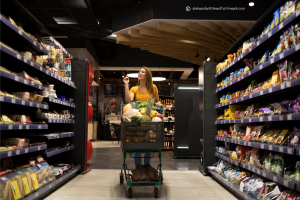Three scenarios for the future of cash
Last year, the Deutsche Bundesbank launched the National Cash Forum initiative. Within this framework, the participants want to find answers to a question that has been on the minds of various cash stakeholders for a long time: How can easy access to cash be maintained for everyone? This requires an idea of what the future of cash might look like. Three scenarios provide insights.
Current cash study – with a big goal for the future
Studies on the use, distribution and acceptance of cash are published regularly. The tenor: alternative means of payment are becoming more and more popular. But cash is still not so easy to shake off. The German Bundesbank is now taking a new approach. In its study, which was conducted by the service company VDI/VDE Innovation + Technik and the opinion research institute Sinus between February 2022 and November last year, scientists, various cash stakeholders and social organisations had their say. ALVARA also took part in the study. Robert Wolf, Managing Director of ALVARA | Digital Solutions, provided valuable insights as an interviewee in the cash stakeholder analysis – read more on page 77. The study is also based on literature research and a representative online survey.
The central question: How will cash be used in the future? The Bundesbank is literally rolling up its sleeves. It wants to get an idea of how cash could be integrated into our society and economy in the future in order to derive recommendations for action. After all, cash plays an important role from various perspectives and should be preserved in the future.
The world of payments in 2037
For this reason, the study analyses current trends and provides an outlook on three payment worlds. All three scenarios have one thing in common: in none of the futures does cash disappear completely, and in two of them it is even almost as important or better than alternative means of payment. This bodes well for finding ways to maintain its attractiveness, acceptance and availability.
Scenario 1: “Hyper-digital payments world”.
Modernisation, digitalisation, innovation – this trio, which will experience a boom in the 2020s, has ushered in the hyperdigital payment world. Cash plays a largely secondary role. Coins and notes are rarely used for payments at the checkout or between two individuals. Even in the former bastions of cash, you will search in vain. Farmer’s markets, flea markets and restaurants are completely cashless and rely on mobile payment terminals.
A development that is seen as unfavourable for the over-80s. Data protection and the complicated handling of non-cash means of payment are at the centre of their anger. But there is no room for these concerns in the political debate.
Online retail is booming. Even goods that used to be bought locally, such as food, are now being bought online at lower prices. Bricks-and-mortar retail is becoming more technologically mature. Pick-&-go systems, where goods are recorded as you shop and paid for quickly at the end using an app, or self-checkout systems with a wider range of functions make shopping convenient. Lightly staffed or unstaffed stores are the new standard, as there is little need for staffed checkouts. There is no difference for stores in rural areas. Here, too, unmanned supermarkets are on the rise.
In the face of increasing digitalisation, governments and companies are focusing on protective measures. Cyber attacks that harm society must be contained. Providers of cashless payment solutions are particularly targeted by attackers.
Scenario 2: “Cash renaissance in the payments world”..
As the use of the term “renaissance” suggests, cash experiences a revival in this future scenario. This was already evident in the early 2020s. The coronavirus pandemic, the war in Ukraine, climate change and the boom in artificial intelligence did not leave German society unscathed. People longed for independence (from other countries), solidarity (for their own economy, especially local shops) and a right to an analogue life (due to the perceived dangers of AI).
In this context, trust in non-cash means of payment declined. Cash, on the other hand, was associated with sovereignty, independence and differentiation from the mainstream of the time, and thus became a lifestyle commodity. Gradually, the benefits spread to many social classes. The abolition of the 1 and 2 cent coins and the introduction of rounding rules also contributed to this by the 2030s.
The trend towards shopping at local retailers continues. As they already offered cash payments in the past and did not switch to cashless means, paying with coins and notes has become a matter of course. However, some large retail chains with digitally savvy customers had already stopped accepting cash payments by the early 2030s. The EU regulation and the German government’s recommendations to accept cash payments prompted them to switch back. All supermarket chains now offer manned checkouts and self-checkout systems again, with at least one unmanned checkout also having a cash payment module.
Savings banks and banks continued to close and ATMs were dismantled, but at a slower pace. This means that access to cash will still be available in 2037.
Scenario 3: “Disappearing hybrid payment world”.
Traditional milieus, the middle class or conservative-establishment milieus – society has become more divided in the 2020s. According to the study, this trend will continue into the next decade. Milieu affiliation influences preferred payment method. Mistrust of digital providers and the state, economic restrictions and disadvantages, or the value of having a quick overview of one’s own spending will continue to drive people into the arms of cash.
However, contrary to previous studies, age no longer plays a role. This is because all age groups are aware of digitalisation. It is now much more the attitude towards the digital world that determines preferences. Informed and sceptical consumers still prefer cash. Convenient, risk-averse shoppers, on the other hand, prefer cashless payment options.
People still use coins and notes for tips, gifts and small amounts. Across all social groups, they value cash as a store of value. However, it can no longer be said to be the only means of inclusion. Non-cash means of payment have been enhanced and, with improved voice input and output technologies, offer a good alternative for people with motor or visual impairments. Parents are increasingly turning to apps that allow their children to spend money under control.
Different payment preferences are also evident in bricks-and-mortar retail. Checkout equipment adapts to customer needs. There are stores with staffed checkouts, unstaffed stores and stores that rely on a combination of staffed checkouts and self-checkout systems. Retailers who are aware of their customers’ preference for cash will offer at least one self-checkout with a cash payment function.
However, the acceptance of cash in retail is declining for one simple reason. The cost of supplying and disposing of cash is a burden. Private banks, co-operative banks and savings banks are closing branches and the ATM network is being further reduced, which has an overall impact on the cash cycle.
Conclusion
I’m sure we all have our own personal predictions about where cash is headed. With 2030 not too far away, it will soon be clear which payments world will win the race. But in the meantime, financial institutions, retailers and value-added service providers should take action. They already face challenges that make cash logistics inefficient, non-transparent and expensive.That’s why our motto is: cash players should prepare for all of the above – and more. Digital solutions that simplify cash management, while allowing for modernity and efficiency, will pave the way for the future.
Want to set the course for a modern cash future now? We can help you!





